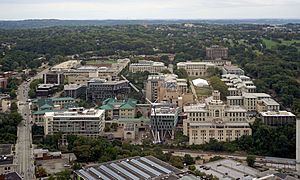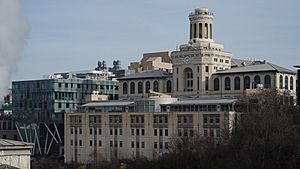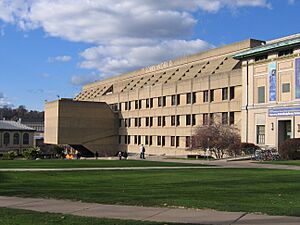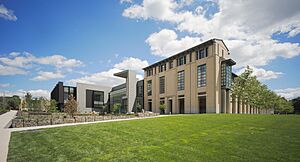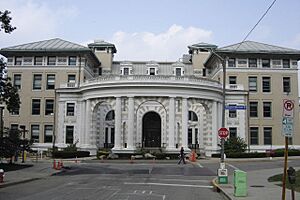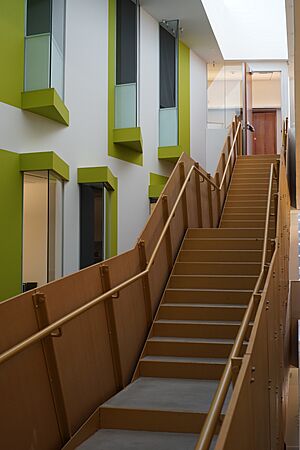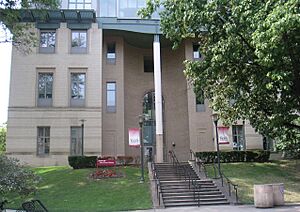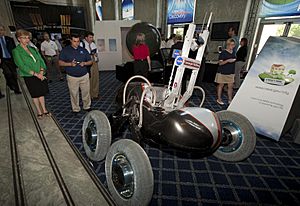Carnegie Mellon University facts for kids
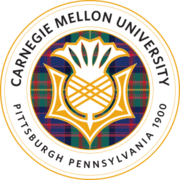 |
|
|
Former names
|
Carnegie Technical Schools (1900–1912) Carnegie Institute of Technology (1912–1967) Mellon Institute of Industrial Research (1913–1967) |
|---|---|
| Motto | "My heart is in the work" – Andrew Carnegie |
| Type | Private research university |
| Established | November 15, 1900 |
| Founders | |
| Accreditation | MSCHE |
|
Academic affiliations
|
|
| Endowment | $4.0 billion (2024) |
| President | Farnam Jahanian |
| Provost | James Garrett |
|
Academic staff
|
1,483 |
| Students | 16,676 (2024) |
| Undergraduates | 7,744 (2024) |
| Postgraduates | 8,932 (2024) |
| Location |
Pittsburgh, Pennsylvania
,
United States
40°26′33″N 79°56′36″W / 40.44250°N 79.94333°W |
| Campus | Large city, 157.2 acres (63.6 ha) |
| Other campuses |
|
| Newspaper | The Tartan |
| Colors | Red, black, steel gray, and iron gray |
| Nickname | Tartans |
|
Sporting affiliations
|
|
| Mascot | Scotty the Scottish Terrier |
Carnegie Mellon University (CMU) is a private research university located in Pittsburgh, Pennsylvania, United States. It's a place where students and professors work together to discover new things and solve big problems.
The university started in 1900 as the Carnegie Technical Schools, founded by Andrew Carnegie. He wanted to create a school that would teach practical skills. In 1912, it became the Carnegie Institute of Technology and began offering four-year college degrees. Later, in 1967, it joined with the Mellon Institute of Industrial Research to become Carnegie Mellon University. The Mellon Institute was founded by Andrew Mellon and Richard B. Mellon in 1913.
CMU has seven main colleges, including the College of Engineering and the School of Computer Science. Its main campus is in Pittsburgh, but it also has locations around the world, like in Qatar, Silicon Valley, and Kigali, Rwanda. Over 15,000 students from many different countries study at Carnegie Mellon, and more than 1,400 professors teach there.
Carnegie Mellon is famous for its new ideas and research, especially in computer science. It was home to the first departments for machine learning, robotics, and computational biology. It also started the first drama program in the United States. CMU is known for being a university with "very high research activity."
The university's sports teams are called the Tartans, and they compete in NCAA Division III athletics. Many famous people have studied or taught at Carnegie Mellon, including Nobel Prize winners, Emmy Award winners, and Tony Award winners.
Contents
University History
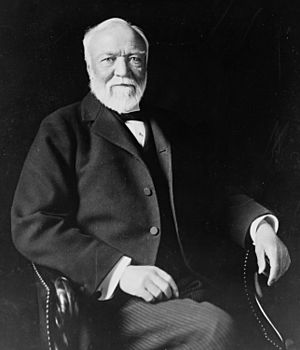
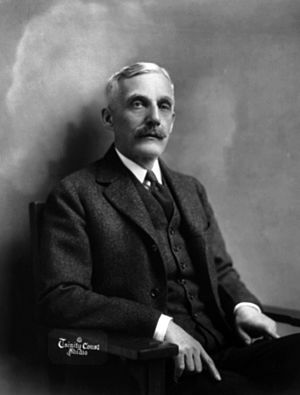
The Carnegie Technical Schools were started in 1900 in Pittsburgh, Pennsylvania. They were founded by Andrew Carnegie, a wealthy businessman who believed in giving back to the community. He wanted to create a school for the children of working-class families in Pittsburgh. Carnegie was inspired by another school, the Pratt Institute in New York.
In 1912, the school changed its name to Carnegie Institute of Technology (CIT) and began offering four-year degrees. It had different schools, including one for fine arts and one for women, called the Margaret Morrison Carnegie School for Women.
The Mellon Institute of Industrial Research was founded in 1913 by brothers Andrew Mellon and Richard B. Mellon. This institute focused on research for businesses and the government. In 1967, the Carnegie Institute of Technology and the Mellon Institute merged to form Carnegie Mellon University.
During the 1970s and 1980s, the university grew a lot. Researchers at CMU became well-known for their work in new fields like robotics and software engineering. For example, the "Andrew" computing network was created in the mid-1980s. This project connected all computers on campus and set a new standard for how universities used technology. On April 24, 1985, cmu.edu became one of the very first internet addresses ending in .edu.
In the 1990s and 2000s, Carnegie Mellon became one of the top universities in the United States and worldwide. It is known for its unique way of combining different subjects in research and education. This led to new fields like computational finance and human–computer interaction.
In 2011, a former businessman named William S. Dietrich II gave a huge gift of $265 million to the university. Because of this generous gift, the College of Humanities and Social Sciences was renamed the Marianna Brown Dietrich College of Humanities and Social Sciences after his mother.
In 2012, Carnegie Mellon joined with other universities to create the Center for Urban Science and Progress (CUSP) in New York City. This center focuses on using science to solve city problems.
In 2022, Carnegie Mellon announced a big partnership with the Mastercard Foundation. They are investing $275.7 million to support Carnegie Mellon University Africa in Kigali, Rwanda. This campus offers advanced degrees in engineering and artificial intelligence. In 2023, Trustee Ray Lane and his wife Stephanie Lane also invested $25 million to support the university's Computational Biology department.
Campus Life
Campus Overview
Carnegie Mellon's main campus is about 157 acres (63 hectares) and is located five miles (8 kilometers) from downtown Pittsburgh. It is next to Schenley Park and close to several neighborhoods. The campus of the University of Pittsburgh is right next door. Carnegie Mellon owns 81 buildings in the Pittsburgh area.
For many years, the main student center was Skibo Hall. In 1994, a new student union was built to replace it, called the University Center. This building was later renamed the Cohon University Center in honor of Jared Cohon, a former president of the university. It has Wi-Fi and many facilities for students.
A large grassy area called "The Cut" runs through the campus. Another grassy area, "The Mall," crosses it. "The Cut" was made by filling in a valley with soil.
Campus Buildings
The first buildings on campus were designed in a style called Beaux-Arts architecture. Many of these original buildings had green tile roofs.
After World War II, the campus grew a lot. New buildings were built in a more modern style to meet the needs of more students. These new buildings were designed to be built quickly and affordably.
Starting in the 1990s, the university added many new buildings. These included a new student center (Cohon University Center), a theater building (Purnell Center for the Arts), a business school building (Tepper School of Business), and several student dorms.
In 2006, a tall sculpture called Walking to the Sky was placed on the lawn near Forbes Avenue. It is 80 feet (24 meters) tall.
The Gates Hillman Complex opened in 2009. It houses the School of Computer Science and has many offices, labs, and classrooms. This complex was made possible by large gifts from the Gates Foundation and the Henry L. Hillman Foundation. A bridge called the Randy Pausch Memorial Footbridge connects it to the Purnell Center for the Arts.
New buildings continue to be added to the campus. The Sherman and Joyce Bowie Scott Hall was built for engineering and research. The Tepper Quadrangle, a new area for the Tepper School of Business, was also developed. In 2020, TCS Hall, an innovation center, was completed. Carnegie Mellon is also building a new mechanical engineering building, an athletics center, and a Science Futures Building.
How the University is Organized
Carnegie Mellon University is made up of several different colleges and schools, each focusing on specific subjects:
- The College of Engineering has seven departments, including Biomedical Engineering, Chemical Engineering, and Mechanical Engineering. It also has institutes for information networking and innovation.
- The College of Fine Arts is one of the oldest fine arts colleges in the U.S. It includes schools for Architecture, Music, Design, Drama, and Art.
- The Dietrich College of Humanities and Social Sciences focuses on subjects like English, History, Psychology, and Statistics. It also offers programs in Information Systems and Economics.
- The H. John Heinz III College of Information Systems and Public Policy offers advanced degrees in areas like Public Policy and Information Systems.
- The Mellon College of Science has departments for Biological Sciences, Chemistry, Mathematical Sciences, and Physics. It is working on new research in neuroscience and nanotechnology.
- The School of Computer Science is known as one of the best in the world. It has departments for Computational Biology, the Robotics Institute, Machine Learning, and Human-Computer Interaction.
- The Tepper School of Business offers programs in Business Administration and Economics. It also has advanced degrees in Business Administration (MBA) and Computational Finance.
Carnegie Mellon also has special programs like the Integrative Design, Arts, and Technology (IDeATe) Network. This network lets students from any college take classes or get minors in areas like Game Design, Animation, and Sound Design. IDeATe also manages the Entertainment Technology Center (ETC).
Academics
University Rankings
Carnegie Mellon is considered one of the top universities in the United States. U.S. News & World Report ranked it among the top 25 American research universities for 2024-2025. Many of its graduate programs are also highly ranked. For example, the CMU School of Computer Science is consistently ranked among the best in the nation, often tied with other top schools like MIT and Stanford.
Globally, Carnegie Mellon is also highly regarded, ranking 28th by Times Higher Education and 52nd by QS World University Rankings.
Student Admissions
Getting into Carnegie Mellon is very competitive. For the class that started in fall 2022, only about 11% of applicants were accepted. The acceptance rates for different colleges and programs can vary. For example, the Carnegie Mellon School of Drama has a very low acceptance rate of about 3%.
The students who enroll at CMU have very strong academic records. The middle 50% of accepted freshmen scored between 720-770 on the reading and writing part of the SAT and 770-800 on the math part. For the ACT, the middle 50% scored between 34 and 35. Carnegie Mellon tries to meet the financial needs of its domestic students.
Research and Discoveries
Carnegie Mellon is known for its "very high research activity." In 2021, the university spent over $400 million on research. A lot of this money comes from the U.S. government, especially from the National Science Foundation and the Department of Defense.
The Pittsburgh Supercomputing Center (PSC) is a joint project between Carnegie Mellon, the University of Pittsburgh, and Westinghouse Electric Company. It was started in 1986 and is a major partner in the TeraGrid, a program that helps with advanced computing research.
The Neuroscience Institute (NI) was founded in 2018. It brings together research in computer science, engineering, machine learning, and cognitive science with basic neuroscience. The goal is to improve human health and well-being. For example, devices developed by the institute have helped patients who cannot speak to communicate.
The Robotics Institute (RI) is part of the School of Computer Science and is one of the top places in the world for robotics research. Its Field Robotics Center (FRC) has created many important robots, including Sandstorm and H1ghlander, which competed in the DARPA Grand Challenge. Another robot, Boss, won the DARPA Urban Challenge. The Robotics Institute has even worked on a robot called Andy to explore the moon.
The Software Engineering Institute (SEI) is a special research center funded by the U.S. Department of Defense and run by Carnegie Mellon. It helps improve software engineering practices for industry and government. The SEI is also home to CERT/CC, a group that works on computer security.
The Human–Computer Interaction Institute (HCII) is another part of the School of Computer Science. It focuses on how people interact with computers, combining computer science, design, and social science.
The Language Technologies Institute (LTI) is known for its research in language technologies, such as machine translation and speech recognition.
The Ray and Stephanie Lane Computational Biology Department develops computer methods to help with biomedical research.
Carnegie Mellon is also home to the Carnegie School of management and economics. This group of thinkers developed important ideas about how people make decisions in business.
Many large companies like Apple Inc., Intel, Google, Microsoft, and IBM have research labs or offices near the Carnegie Mellon campus. This helps create opportunities for students and professors to work with these companies.
Global Reach
Besides its Pittsburgh campus, Carnegie Mellon has a campus in Doha, Qatar. This campus offers undergraduate degrees in computer science, business, and information systems. It is part of Education City, where several other U.S. universities are located.
CMU also has graduate campuses in Mountain View, California, in the heart of Silicon Valley. The Tepper School of Business has a center in Manhattan, New York, and the Heinz College has one in Adelaide, Australia. Carnegie Mellon also has centers in Washington, D.C. for degree programs and research.
The Information Networking Institute offers graduate programs in Athens, Greece and Kobe, Japan. The College of Engineering has an international campus in Kigali, Rwanda, offering master's degrees in Information Technology and Electrical and Computer Engineering.
University Libraries
Carnegie Mellon has several libraries, including Hunt Library, the Roger Sorrells Engineering & Science Library, and the Mellon Institute Library. The university's libraries also have special collections of historical documents and art. Students and professors can also use the Carnegie Library of Pittsburgh and some University of Pittsburgh libraries.
Carnegie Mellon also works with the University of Pittsburgh on many academic and research projects. They share resources and offer joint degree programs.
Student Life
Carnegie Mellon has over 400 student groups, art galleries, and unique traditions. These groups offer social, service, academic, and recreational activities. The university has a strong Scottish theme because of Andrew Carnegie's Scottish background and the Mellon family's Scots-Irish heritage. This is why the mascot is Scotty, a Scottish Terrier, and the student newspaper is called The Tartan.
Student Housing
Carnegie Mellon offers different types of housing for its students. Students can choose from traditional dorm rooms, semi-suites, suites, and apartments. Traditional dorms have rooms for 1-3 people with a shared bathroom down the hall. Semi-suites offer more privacy with 1-4 person rooms and a semi-private bathroom shared by a few residents. Suites are similar but also include a living room. Apartments are shared by 1-3 people and have bedrooms, a bathroom, living room, and kitchen.
First-year students live in specific residence halls like Morewood E-Tower and Stever House. About one-third of older students choose to continue living in university housing, which includes apartments and townhouses.
Fraternities and Sororities
The first fraternity at Carnegie Mellon, Theta Xi, was founded over 100 years ago in 1912. Fraternities and sororities are social organizations that students can join.
Special Communities
Some housing options are designed for specific student communities. For example, Welch House hosts a Queer community, which is a living space for non-binary students and others who prefer an inclusive environment. Spirit House is a community for members of the SPIRIT student organization, which is a Black Student Union that supports Black students at CMU.
University Traditions
One of Carnegie Mellon's most famous traditions involves "The Fence." In the early days, there was a bridge where students would meet. When the bridge was removed, a wooden fence was put in its place. One night, a student group painted the fence as a prank. Since then, painting The Fence has become a tradition.
The Fence is located in the center of campus. Student groups guard it 24 hours a day. As long as two students are guarding it, no other group can "take" the fence. The group guarding it can then paint it between midnight and 6 AM. Only hand brushes can be used; spray paint is not allowed. The old paint is never removed, so each new painting adds another layer. The original wooden fence eventually collapsed from the weight of all the paint and was replaced with a concrete one. Today, The Fence is known as "the world's most painted object" by the Guinness Book of World Records.
Athletics
The Carnegie Mellon Tartans are part of the University Athletic Association in NCAA Division III. Before World War II, Carnegie Mellon (then Carnegie Tech) played against teams that are now in NCAA Division I. In 1936, the Carnegie Tech riflery team won the national championship.

CMU has varsity teams for sports like basketball, track, cross country, football, golf, soccer, swimming, volleyball, tennis, and softball. There are also club teams for sports like ultimate frisbee, rowing, and hockey. Carnegie Mellon also has a popular intramural sports system, where students can play different sports for fun.
Football
On November 28, 1926, the Carnegie Technical Institute football team beat the undefeated Notre Dame Fighting Irish 19–0. This was a huge upset, so surprising that Notre Dame's coach, Knute Rockne, had skipped the game to scout another team. ESPN later called this game the fourth-greatest upset in college football history.
Since 2014, the Tartans football team plays in the Presidents' Athletic Conference. The head coach is Ryan Larsen. The team recently had a 17-game winning streak, which was the longest across all NCAA divisions at the time.
Track and Cross Country
The men's cross country team has been very successful, finishing in the top 15 nationally for the past three years. The men's track team has also had several individual All-Americans, who are recognized as top athletes in the country.
Intramural Sports
Students can join intramural sports teams for fun and competition. These include sports like wiffle ball, dodgeball, basketball, flag football, and ultimate frisbee.
Famous Alumni and Faculty
Carnegie Mellon has over 117,000 alumni around the world. Many of its former students and professors have achieved great things. This includes 21 Nobel laureates, 13 Turing Award winners (a top award in computer science), and many winners of Emmy Awards, Tony Awards, and Academy Awards.
Famous alumni in the arts include artists Andy Warhol and Philip Pearlstein, and actors like Holly Hunter and Zachary Quinto.
In the sciences and technology, notable alumni include Charles Geschke, who co-founded Adobe Systems; Stephanie Kwolek, who invented Kevlar; James Gosling, who created the Java programming language; and Scott Fahlman, who created the emoticon. John Forbes Nash, a 1948 graduate and Nobel Prize winner, was the subject of the book and movie A Beautiful Mind. Judith Resnik, an astronaut, was also a CMU alumna.
Alumni in politics include U.S. Representatives Susie Lee and Sydney Kamlager-Dove.
See also
 In Spanish: Universidad Carnegie Mellon para niños
In Spanish: Universidad Carnegie Mellon para niños
- Association of American Universities
- Association of Independent Technological Universities
- Astrobotic Technology
- Disney Research
- EteRNA
- IBM/Google Cloud Computing University Initiative
- List of Carnegie Mellon University people
- List of Carnegie Mellon University traditions


